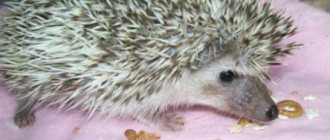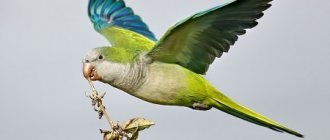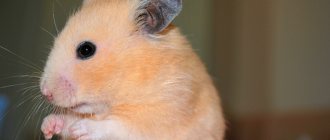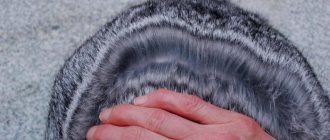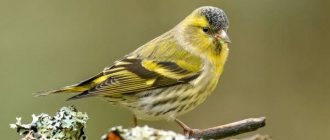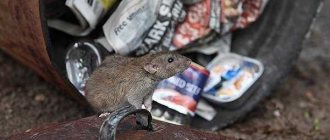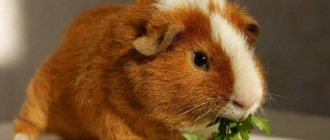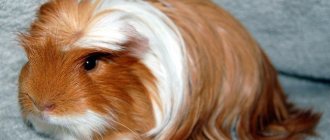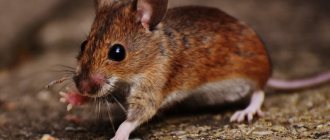The Jaco parrot is considered one of the most beloved pets, as the bird has a number of unique abilities. Despite the modest colors of its plumage, the parrot has the ability to imitate various sounds, including human speech, which is considered unique.
A gray parrot can remember up to hundreds of different words and phrases. It should be noted that this bird is quite noisy, so not everyone can tolerate the presence of such a sociable pet in their home. There is information that gray parrots were kept as pet birds back in the days of ancient Rome, as well as by King Henry VIII. The Portuguese sailors simply adored him.
Description of Jaco
The African gray parrot belongs to the parrot family, a genus of blunt-tailed parrots. It has a fairly large body size of 30 - 35 cm. The wingspan is 65 cm, length is 22 cm. The tail is 8 cm, has a rectangular shape. The beak is black, curved. Quite massive, which allows you to freely deal with rough food. The nostrils, cere and frenulum are leathery. The iris is yellow, the eyes of young chicks are black, and over time acquires a light shade. The edging around the eyes is light ash in color and has no feather cover. The legs are ashen in color and covered with small scales.
The plumage is not thick and visually similar to snake scales. Females are smaller than males, have a dome-shaped head, and a small beak. It is difficult to distinguish the gender. Age after one and a half years is almost impossible to determine visually.
Has the intelligence of a four year old. Copes well with solving intellectual problems.
Can imitate a person's voice. Can master a vocabulary of 1,500 words, speaks well-meaning sentences, and is always happy to engage in dialogue. Loves to play various games with human participation.
The smartest parrot Alex
Alex was an African parrot born in 1976. He became famous for being the subject of a psychological experiment at three universities - the University of Arizona, Harvard and Brandeis University.
His uniqueness lay not only in his ability to learn the names of individual objects, but also in his ability to identify objects and their colors regardless of their shape.
In 1977, Irene Pepperberg, a scientist, psychologist and professor at Brandeis University and Harvard University, bought one-year-old Alex from a pet store. At the time, she wanted to test whether these birds could cope with complex language-related problems. He demonstrated the intelligence of a five-year-old and the emotional level of a two-year-old, and he had not developed to his full potential by the time of his death, Pepperberg said.
In her study, Pepperberg argued that if the intelligence of one bird could be compared to that of dolphins and primates. Or maybe he was an unusual one who learned a large number of words in a short time. Perhaps he did not study them mechanically, but rather creatively with the ability to understand what he said.
When asked about the shape, color or material of a certain object, Alex could give an accurate description. For example, when he was shown keys of different sizes, shapes and colors, there was no problem identifying the object. When he was put in front of a mirror and asked, “What color are you?” he said he was grey, looking at himself. He learned that his color was gray after being told six times. To this day, Alex is the only animal that answers the question about itself.
Alex died suddenly in two thousand and seven, at the age of thirty-one. Although they live on average sixty years, his death came as a surprise to everyone who was interested in this study, especially considering that he was in good health.
Pepperberg said it's a huge loss, but it won't stop her bird research. After all, she has two more birds in her laboratory, but they are not as capable as their predecessor.
Types of Jaco parrot
There are external differences between Jaco species. Moreover, everyone has the same preferences. Today three types are known:
- Brown-tailed Jaco - endowed with a dark gray plumage color, a milky or ivory beak. Smaller in size than their counterparts. Has an average body size up to 30 cm.
- Red-tailed Jaco has light gray plumage with red tail feathers. The beak is black. In Africa, it was believed that this color was good luck and parrots were captured for their red feathers, which served as decorations. The body length of an adult parrot does not exceed 37 cm.
- Royal Jaco or Ghanaian Princess Jaco is an amazing, elegant plumage color; among the main dark gray there are chaotically located red ones. This parrot looks original and luxurious. This species is the largest among its family members. The first mentions appeared in 1909.
There have been recorded cases of parrots being bred in an artificial environment that lack pigment or have a yellow or pink tint to their feathers.
There are also cases when the parents of the brown-tailed Jaco gave birth to chicks belonging to a different subspecies. What causes this mutation is a question scientists cannot answer; this topic remains unknown.
Spreading
In general, there are more than three hundred and at least a dozen that are known to us and are kept as pets. Jaco is rare in our country; its people could not even see it live before, although they had heard a lot about this species.
For some reason, this particular species was prohibited from being imported into the Union of Soviet Socialist Republics; even now you rarely see them on the territory of our countries. Representatives of the species live in Africa and are able to quickly get used to people.
Habitat and lifestyle
Grays in nature live in small flocks or groups. They try to settle and make nests on tall tropical trees in a dense forest that occupies huge areas. How to protect yourself from predators and poachers. At dawn, parrots go in search of food, and in the evening they return to the treetops to roost for the night. It feeds on seeds, fruits, vegetables, and cereals. Sometimes they cause damage to banana plantations and agricultural fields.
Habitat of Jaco parrots Central and Western Africa.
- The large gray parrot prefers to occupy coastal areas - Guinea, Congo, Tanzania, and tries to settle in coastal areas of lakes and river banks;
- The king parrot settled in the central part of the continents and islands of the Gulf of Guinea.
- The red-tailed species has chosen tropical zones, lives near bodies of water, and settles north of the equator and in the south - Northern Angola and the southern regions of Congo and Tanzania.
Nutrition
The African gray parrot eats only plant foods. From a young age, he learns not only to look for food, but also to distinguish edible plants from poisonous ones. Basically, the Gray eats various fruits. The diet of the African gray parrot includes the following components:
- flowers;
- bark;
- grains;
- seeds;
- succulent shoots;
- green leaves;
- fruits;
- nuts.
Although the African parrot flies heavily and reluctantly, it travels considerable distances in search of food. To select ripe fruits and nuts, the Gray Gray flies from one tree to another and even climbs branches with the help of a powerful beak and tenacious fingers. The African gray parrot often raids plantations with unripe corn, causing discontent among farmers.
Keeping Jaco at home
Breeders consider Jaco to be an almost ideal bird. Keeping Jaco at home must be taken seriously. You need to be prepared to accept Jaco with some peculiarities. The parrot has a loud voice, can whistle, click its beak, mutter and make all sorts of sounds. Excessively inquisitive and observant. He chooses his favorite among family members. She tries to show him care in every possible way. He is ready to follow his chosen one everywhere, tries to participate in literally all matters. Sometimes he even sits on an armchair or sofa with his owner to watch TV. Requires a lot of attention and can periodically show jealousy.
Arrangement of the cage
The Jaco parrot is unpretentious, but it must be taken into account that the bird is large. The cages or aviary in which the birds will be kept must be large. The bird is active, quite mobile, loves to frolic so that space does not hinder Jaco’s movement. The bars of the walls are exclusively metal. Put a lock that is difficult for the bird to open. The cage for the Jaco parrot needs to be well equipped and everything must be firmly secured. Place a drinking bowl, several feeders for food and mineral supplements. Add accessories, attach the ladder, perches, wheels, mirror. Provide various food toys for Jaco so that during your absence the pet does not get bored and has fun with the toys.
Every day you should let him out of the cage so that he can fly freely in the home space and be in contact with you more often. The lighting in the room is diffuse. He needs more than 10 hours of rest to sleep and recuperate. If necessary, darken the cage.
Diet
Nutrition should be varied and balanced. The Jaco parrot is completely unpretentious in food and does not require refined and exotic food. Prefers to eat:
- Vegetables and fruits;
- Young branches of fruit trees and shrubs;
- Various nuts, but almonds are contraindicated;
- Properly selected grain mixture and sprouted grain;
- Mineral and vitamin supplements;
- All food must be fresh and of high quality.
Care and hygiene
Jaco loves to splash in the water and wash his feathers. This procedure gives him great pleasure. You can swim 2 times a week. For swimming, you can put a bathhouse or any other container with water. Pamper yourself with a trickle from the shower, but in all cases the water is only warm.
The Jaco parrot's cage should be cleaned when it gets dirty, but at least once a week. Clean food feeders daily. Change the water every day. Wipe and rinse accessories.
Diseases and their prevention
Gray parrots, like all animals, are susceptible to various diseases. The most common threats that contribute to the disease:
- Unsanitary conditions in the cell are due to the development of bacteria. Stagnant water and stale food will lead to various diseases;
- Poor quality and poor nutrition, lack of vitamins and minerals;
- Psychological or physical disorders from lack of attention.
Diseases are divided into three types:
- Non-contagious – obesity, poisoning, feather plucking;
- Infectious – tuberculosis, which is incurable, paratyphoid fever, aspergillosis;
- Parasitic – helminthiasis or fluff eaters.
The listed diseases are visible visually; timely measures and treatment will lead to a quick recovery of the parrot.
Causes of death
Birds often die after advanced forms of the disease or injuries. You may injure yourself on furniture, hit a window glass, or suffer from an electrical discharge. Do not leave a free-flying parrot alone at home.
Important! The Jaco bird suffers without lack of attention, which affects the physical and psychological health of the pet.
Be attentive to the behavior of the parrot; when sick, the mood and behavior immediately changes, appetite disappears, lethargy and irritation appear. This should serve as an alarm.
Answers to frequently asked questions about gray parrots
Which floor is better?
Some sources like to point out that males have better speaking abilities. It is not true. Gender doesn't matter. As with people, the personal characteristics of the bird are much more important.
At what age can you buy a chick?
Most parrot breeders advise buying at 3-4 months of age. At this age, the nursing chicks are completely emancipated, but at the same time obedient and interested in interacting with people. Although there are other opinions. For example, the Italian nursery Centro de Cria PSITTACUS recommends taking it at 70 days of age. This is explained by the fact that at this age the most important stage of development begins - socialization, which determines the future behavior of the parrot. But at this age, the chicks will have to be fed manually for some time.
Parrots and children
Parrots are social birds; interaction with other members of the article is a natural element of life for them. If you realize that any living creature is not a toy, and are able to provide it with proper care, attention and control, then such a neighborhood is quite acceptable. Some are afraid of the bird's jealousy in a situation if the child was born after the appearance of the bird. In this case, in order to avoid jealousy and other difficulties, you will have to be especially sensitive - provide your winged friend with the same care and attention, teach your child how to properly communicate with your pet.
Other animals
From our point of view, such a neighborhood carries a potential danger and it is better that it does not exist. Although it is worth noting that there are many examples of peaceful cohabitation of a large parrot with dogs and cats (including from reputable breeders).
Is it possible to leave a bird alone in a room?
Our apartment contains a lot of potential dangers - indoor plants (some of them are poisonous), electrical wires and sockets, household appliances, wallpaper. Some owners adapt the room directly for the winged pet, which makes it safe even in the absence of people. Otherwise, such walks carry risks.
How to determine gender?
Experienced breeders are able to determine the sex with a fairly high degree of accuracy based on some visual signs - head shape, shades of color. However, the most reliable way to determine gender is DNA analysis.
Is it normal for white powder to appear on feathers?
Yes, good. This powder helps keep feathers in good condition. Just wash your pet regularly (with a spray bottle, for example) to control the amount of powder on the wings.
Is food from our table acceptable?
Gray parrots, being flocking birds, will try to taste what you eat. This is unacceptable, because most human food is dangerous for them. The best solution in such a situation would be to switch attention from human food to safe and healthy food, for example, putting it on the same plate as yours.
Seasonality of food
In nature, the diet of birds varies depending on the time of year. Changing your diet is an integral part of your diet. Therefore, it is completely normal if in summer you offer some types of fruits that are in abundance in summer, and in winter other types.
Do I need to clip my wings?
Definitely not! Flight helps give the bird the necessary physical activity that cannot be obtained in any other way, and it also helps to learn to control and coordinate its movements. In addition, wing clipping can contribute to behavioral problems.
How to properly cage?
From the first day, it is necessary to properly train the Gray to enter the cage.
What not to do:
- forced to return to the cage by force, caught with a towel or wearing protective gloves;
- lure by putting a treat inside.
What do we have to do:
- be willing to spend time learning;
- regularly carry it on your hand into the cage, but without closing it;
- tame to the team for independent entry (for example, “home”);
- when following a command, emotionally praise and reward with a treat;
- after entering the cage, stay next to it for some time and communicate with the parrot.
Will he talk?
Almost every owner wants a talking gray parrot and asks the question: will his pet talk? This species has excellent abilities to learn human speech. We recommend that you read the material “how to teach a parrot to talk,” which provides useful recommendations for teaching conversation. Imitating sounds is a natural behavior for most parrots. If your pet feels like a member of the family and actively participates in family life, then its motivation to learn will be maximum.
How to deal with screaming?
What not to do:
- scold, shout back at him;
- lose patience and react when the bird screams long and persistently.
What do we have to do:
- ignore the scream;
- if the winged one behaves as it should, then praise it, reward it, show that you are satisfied;
- spend time working with your pet when he is calm.
How often do you visit the veterinarian?
It is best to make such visits annually. Regular visits to an experienced veterinarian will help detect abnormalities and problems, which means timely action can be taken.
Intelligence
The Jaco parrot has unique intelligence and exceptional memory. Good learning ability, dynamic, observant and curious. She copes with tasks without much difficulty and does everything with great pleasure. Easily reproduces sounds and repeats intonation. Jaco's character is not an easy one. Females are calmer and more silent than males, who often behave more irritably.
Once in the home environment, he looks closely at those around him for a long time. The taming of the Jaco occurs gradually, adaptation to home conditions occurs quickly. Gradually begin to memorize words, short phrases, perform various tricks and tasks, try to make it more difficult each time. Dedicate to studying every day, but you need to have a lot of patience. The result will not keep you waiting. Learn and develop from 2 - 3 months.
General health problems
African Grays may be predisposed to feather plucking, calcium deficiency, vitamin A and vitamin D deficiency, respiratory infections, psittacosis, and the beak and feather disease ornithitis.
Vitamin deficiencies can be prevented by providing your bird with a wide variety of fruits, as well as vegetables high in beta-carotene, such as cooked sweet potatoes and fresh cabbage.
Feather picking is usually a sign of a bored bird that is not getting enough mental stimulation, attention or exercise.
Breeding Jaco
The gray parrot is considered monogamous; pairs are created for a long time. In the wild, breeding occurs during the rainy season. The males begin to court the female they like, dancing courtship dances, and feeding her. After all the rituals, the couples separate from the group and make nests in hollows. The female lays 3 – 4 eggs. It incubates for about a month. After the birth of the offspring, the first time remains in the nest, and the male provides food and acts as a protector. After two or more months, the babies leave their parents' nests, but the Jaco chicks remain under the care of their parents for some time.
Breeding at home is problematic. Nesting from October to May. Couples can live together all their lives, but they do not have offspring. This process requires the sympathy of partners. If an artificial couple gets together, then it is luck. The process becomes noticeable through courtship. You need to place a nest and try not to disturb it during this period.
Price
Many people wonder: how to choose a Gray and how much does it cost? Pets live on average from fifty to sixty years, so when you buy a pet, you are buying a friend for life.
Thanks to their talents, birds are very popular. There is a brown-tailed species and a red-tailed one, their cost differs significantly, due to what the species looks like. So, untrained speech in the market or on the Internet through various advertisements can be purchased for 15 - 35 thousand rubles.
It all also depends on where you purchase the animal. The cost is higher in a pet store, where their price is approximately seventy to one hundred and fifty thousand rubles. They usually have their own catalog, which can be viewed online.
Breeders have fosterlings in the price range from sixty to one hundred and twenty thousand rubles. Even those who can speak and are quite old cost from three hundred thousand rubles and even more. Don’t forget to include in the price what you will feed your pet.
Next
Gray Red-tailed Gray and all information and breed
What do young parrots look like?
Gray Gray chicks have almost black irises. The skin around the eye sockets and on the paws is thin, smooth, and pink in color. The white edging of the feathers is still missing. The feathers can be milky or beige; under the tail they are not yet bright red, but dark, as if dirty.
As soon as the Gray chick becomes older than 8 months, its iris will lighten and later become bright yellow. This will happen in the third year of life. Gray chicks with gray, whitish, smoky eyes are young parrots up to 2 years old.
On a note! Gray chicks up to 1 year old are suitable for taming and training. They make contact more easily, remember new words faster, and their character is more flexible.
The plumage of Gray Gray chicks is pale gray, dirty beige, and inconspicuous. Gradually, by about a year or two, it will acquire the ash-gray color with white streaks typical of an adult.
Causes of death
A common cause of the premature death of Jaco is errors in maintenance that lead to the pet's illness. Self-medication and delaying the moment of contacting an ornithologist greatly reduce the likelihood of a favorable outcome for the parrot.
There are also frequent cases of poisoning, as well as death of birds from accidents. In order for your pet to live a long and happy life, it is necessary to take timely preventive measures to prevent diseases, monitor the behavior of your feathered friend and, at the slightest sign of ill health, consult a specialist.
Peculiarities
Before getting a Gray, it is important to know that they will take up a lot of your time. This bird cannot live without communication and becomes very attached to its owner; it is distinguished by its intelligence, observation, but also its wayward character and jealousy if it feels that its owner is devoting time to someone else other than him.
If you do not take care of the bird, leave it for a long time, or leave, then self-plucking may occur. Jaco begins to pluck his own feathers and injure himself.
Aggression towards itself is met with retaliatory aggression. Big bird bites can become quite serious, making it very difficult to establish contact with the offended pet in the future.
Lifespan
A significant role in the life expectancy of a parrot is played by the correct provision of necessary assistance in case of illnesses and possible injuries.
It depends on complete proper care and safety outside the cage.
In comfortable conditions, the average life expectancy of a Gray Gray is about 25 years. The maximum age of parrots of this species is about 50 years.
Artificially eaten subspecies
Currently, there are many more subspecies of gray parrots than exist in nature. All of them were bred artificially by ornithologists.
Here are some of the new subspecies of the African gray bird:
- Gray-pink are parrots whose feather edges are pink rather than white.
- Albinos are completely white individuals.
- Yellow birds are lutinos. Their plumage is pale yellow, almost beige.
These birds can be purchased at any reputable nursery. Ornamental parrots of the yellow gray breed look bright and unusual.
The gray parrot is an exotic bird with a difficult character. If you purchase a young specimen and give it enough time and attention, you can raise an intelligent and devoted friend who will delight you with his company for many years.
